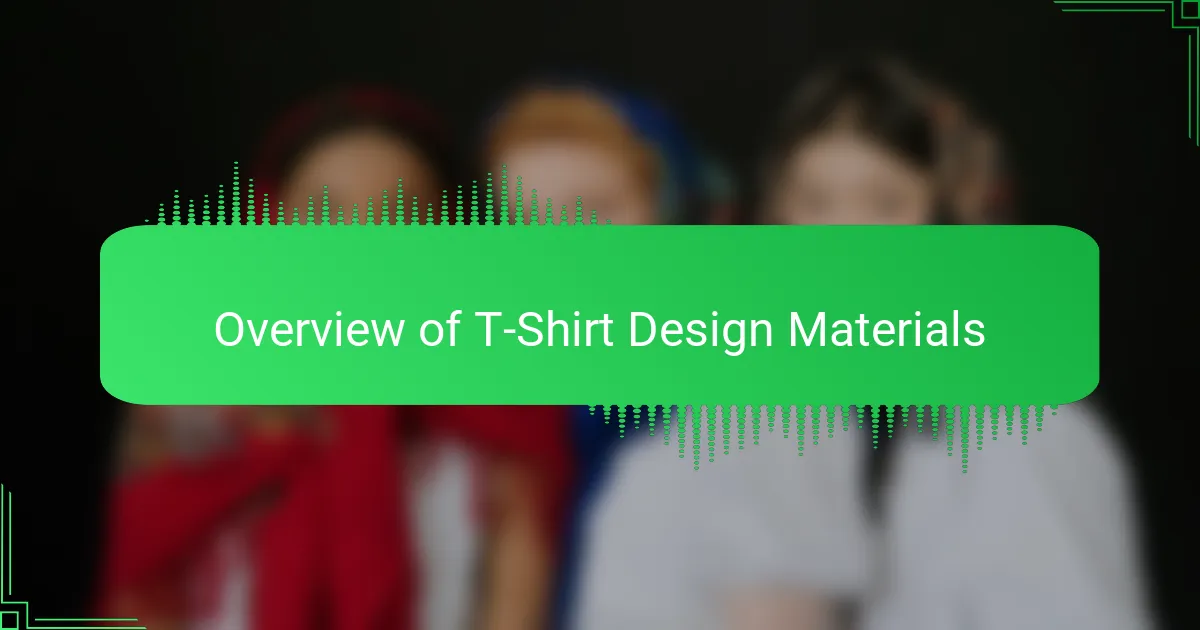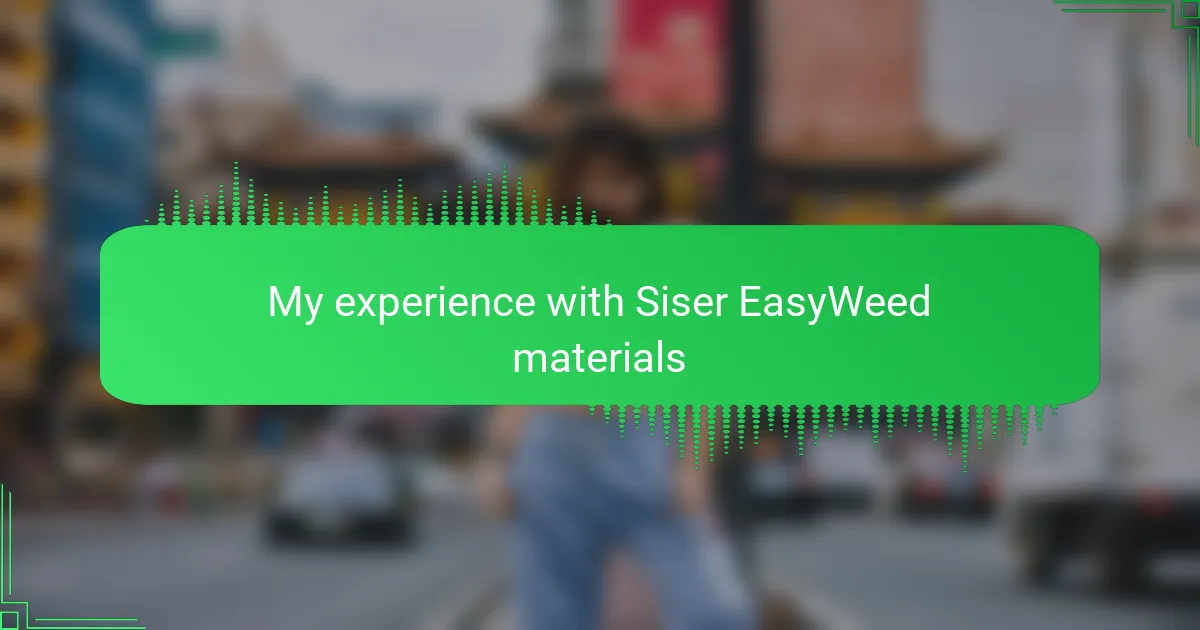Key takeaways
- Siser EasyWeed heat transfer vinyl is thin, flexible, and durable, making it ideal for detailed t-shirt designs.
- Proper preparation, such as washing, ironing, and preheating the shirt, enhances application results and design longevity.
- Consistent pressure during heat pressing is crucial to ensure adhesion and prevent lifting of the design.
- Adjusting heat press settings and allowing the carrier sheet to cool before peeling can prevent design issues like peeling edges.

Introduction to Siser EasyWeed
Siser EasyWeed is a heat transfer vinyl that has quickly become my go-to choice for t-shirt design projects. Its ease of use really stands out—I remember my first project felt so straightforward compared to other materials I’ve tried. The vinyl’s thin and flexible texture makes it a dream to work with, especially when layering designs.
| Feature | My Experience |
|---|---|
| Ease of Use | Simple to cut and weed, even for intricate designs. |
| Material Thickness | Thin and lightweight, making the final t-shirt comfortable to wear. |
| Durability | Holds up very well after multiple washes without cracking. |
| Adhesion | Strong bond with fabric, no peeling noticed so far. |
| Variety | Available in many colors and finishes, perfect for creative projects. |

Overview of T-Shirt Design Materials
Siser EasyWeed is a standout among t-shirt design materials I’ve tried. Its thin, flexible texture makes it incredibly easy to work with, especially when layering designs. Compared to other materials, it adheres well and withstands washing without cracking or peeling, which gave me great confidence in its durability.
| Material | Key Characteristics |
|---|---|
| Siser EasyWeed | Thin, flexible, excellent heat transfer, durable after washes |
| Vinyl | Thicker than EasyWeed, can feel stiff, good for bold designs |
| Screen Print Ink | Soft feel, good for large areas, less durable than heat transfer vinyl |
| Printable Heat Transfer Paper | Allows full-color prints, but less flexible and washes out faster |

Key Features of EasyWeed Heat Transfer Vinyl
What really strikes me about EasyWeed is how effortless it is to cut and weed, even when my designs get super detailed. I remember tackling a small, intricate logo and wondering if I’d mess it up, but the vinyl just peeled away so cleanly—it felt like it was made for precision.
Another feature that won me over is its thinness. When I wear a t-shirt decorated with EasyWeed, it never feels heavy or stiff. Honestly, I’ve had designs layered for a bold look, and yet they stayed soft and flexible, which isn’t always the case with heat transfer vinyl.
Durability was a big question mark for me at first. Could something so thin last through washes without cracking or peeling? After numerous cycles, I’m happy to say it hasn’t budged. It’s comforting to know that my hard work will look great for a long time—don’t you hate it when designs start to fall apart so quickly?

Preparing T-Shirts for EasyWeed Application
Getting my t-shirts ready for EasyWeed was surprisingly straightforward, but I quickly realized that the prep work really sets the stage for a smooth application. I used 100% cotton tees because I’d read they give the best results with heat transfer vinyl. Making sure the shirts were clean and wrinkle-free was a small step that I initially underestimated but came to appreciate.
I always preheat the shirt for a few seconds before placing the vinyl. This little trick helps remove moisture and smooths out the fabric, which I found prevents any bubbling or lifting later. Here’s what I found essential for prepping t-shirts before using EasyWeed:
- Wash and dry the shirt beforehand to remove any sizing or chemicals
- Iron or heat-press the shirt briefly to eliminate wrinkles and moisture
- Lay the shirt on a hard, flat surface for even pressure during application
- Position the design carefully before pressing to avoid misalignment
- Use a heat-resistant cover sheet or parchment paper to protect the design and shirt
- Allow the shirt to cool before peeling off the carrier sheet for clean removal
I learned that this prep routine saved me from a lot of frustration and really helped my designs look professional. Have you tried preheating your shirt before? It’s a game-changer in my book.

Applying EasyWeed to T-Shirts Step by Step
Applying EasyWeed to t-shirts is surprisingly simple once you get the hang of it. I usually start by placing the vinyl design shiny side up on the shirt, making sure it’s perfectly positioned—there’s nothing worse than realizing you’re off-center after pressing. Then, I cover it with a heat-resistant sheet and press firmly with my heat press or iron, usually around 305°F (150°C) for about 10-15 seconds; this timing worked well for me across different fabrics.
One thing I learned through trial and error is the importance of consistent pressure. At first, I wasn’t pressing evenly and ended up with some edges not sticking properly, which was frustrating. After adjusting to firm, steady pressure and a hard surface, my designs came out smooth with no lifting. I find it helpful to count seconds out loud during pressing—it keeps me focused and avoids rushing the process.
Peeling the carrier sheet is where patience pays off. I usually wait for it to cool down before peeling, as recommended, and this little pause made a huge difference in getting crisp edges without pulling up the vinyl. Have you ever rushed peeling and accidentally ruined a perfect design? Trust me, letting it cool feels like a small chore but really saves your work.

Personal Experiences and Tips
Working with Siser EasyWeed materials has genuinely transformed my approach to t-shirt design. The first time I tried it, I was amazed by how effortlessly the material peeled away after cutting—this made the whole weeding process much less frustrating. It’s one of those products that feels like it was designed by someone who understands the pain points of crafters.
One tip I found incredibly helpful is to adjust the heat press settings slightly lower than recommended to avoid scorching the fabric. I learned this after a small mishap that left a faint mark on my favorite shirt, but since then, my transfers have been flawless and durable.
- Use a sharp blade for clean cuts and easy weeding
- Peel the carrier sheet warm for better adhesion
- Test press on a scrap fabric to find optimal heat and time settings
- Store the material in a cool, dry place to maintain its quality
- Experiment with layering colors for more complex designs

Troubleshooting Common Issues with EasyWeed
One of the trickiest moments I faced with EasyWeed was dealing with peeling edges after heat pressing. At first, I felt frustrated because my designs looked perfect, but a day later, small sections started lifting. It made me realize how crucial the right temperature and pressure settings are to ensuring the material adheres properly and lasts longer.
Through trial and error, I found a few reliable fixes that transformed my experience. Adjusting the heat press to the recommended temperature of 320°F and maintaining firm pressure made a big difference. Also, waiting for the material to cool before peeling the carrier sheet helped avoid stretching or tearing the design. Here are some common troubleshooting tips I’ve learned along the way:
- Double-check the heat press temperature; too low or too high can cause peeling.
- Apply firm, even pressure throughout the pressing time.
- Peel the carrier sheet while it’s warm or cool, depending on the EasyWeed type.
- Use a lint roller to clean the shirt surface before pressing to improve adhesion.
- Avoid stretching the shirt immediately after applying the design to prevent deformation.
